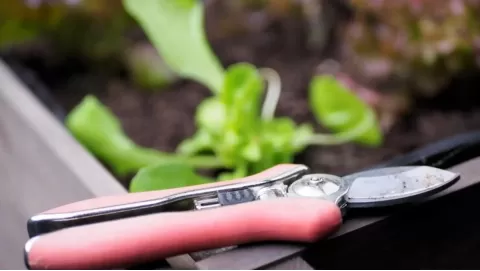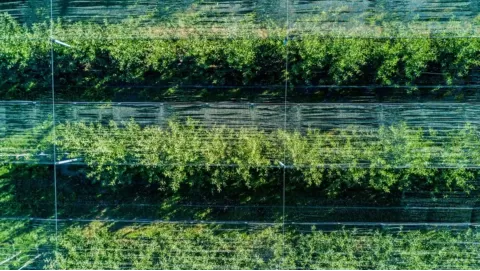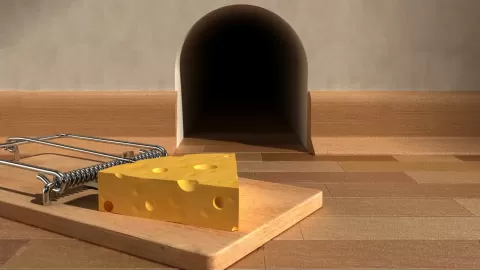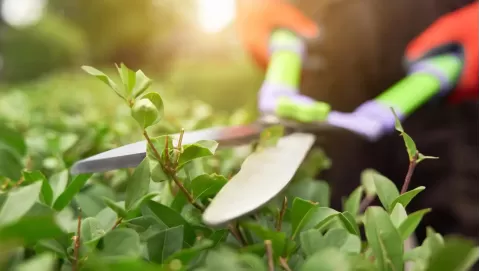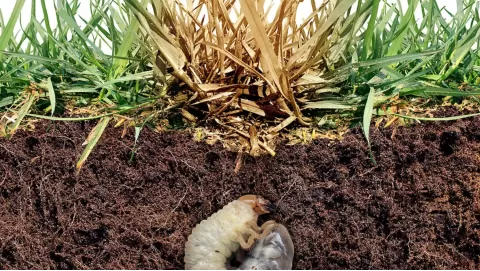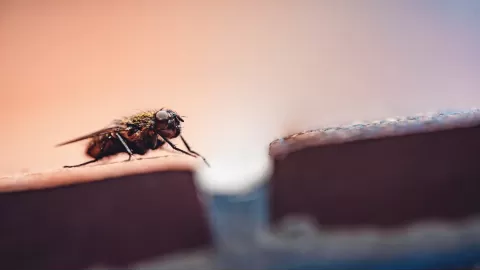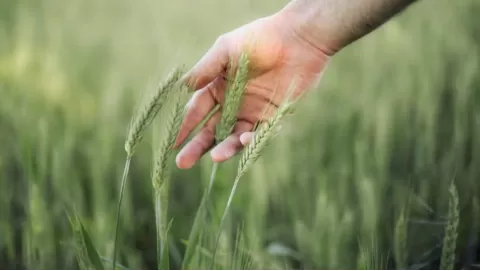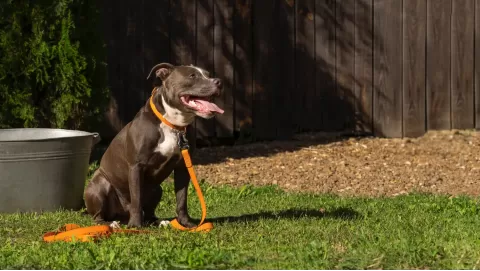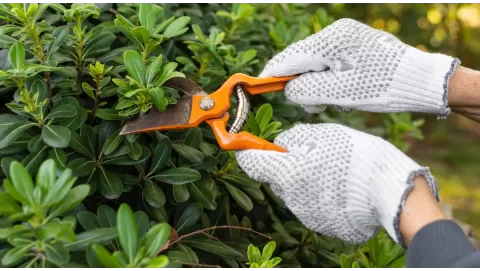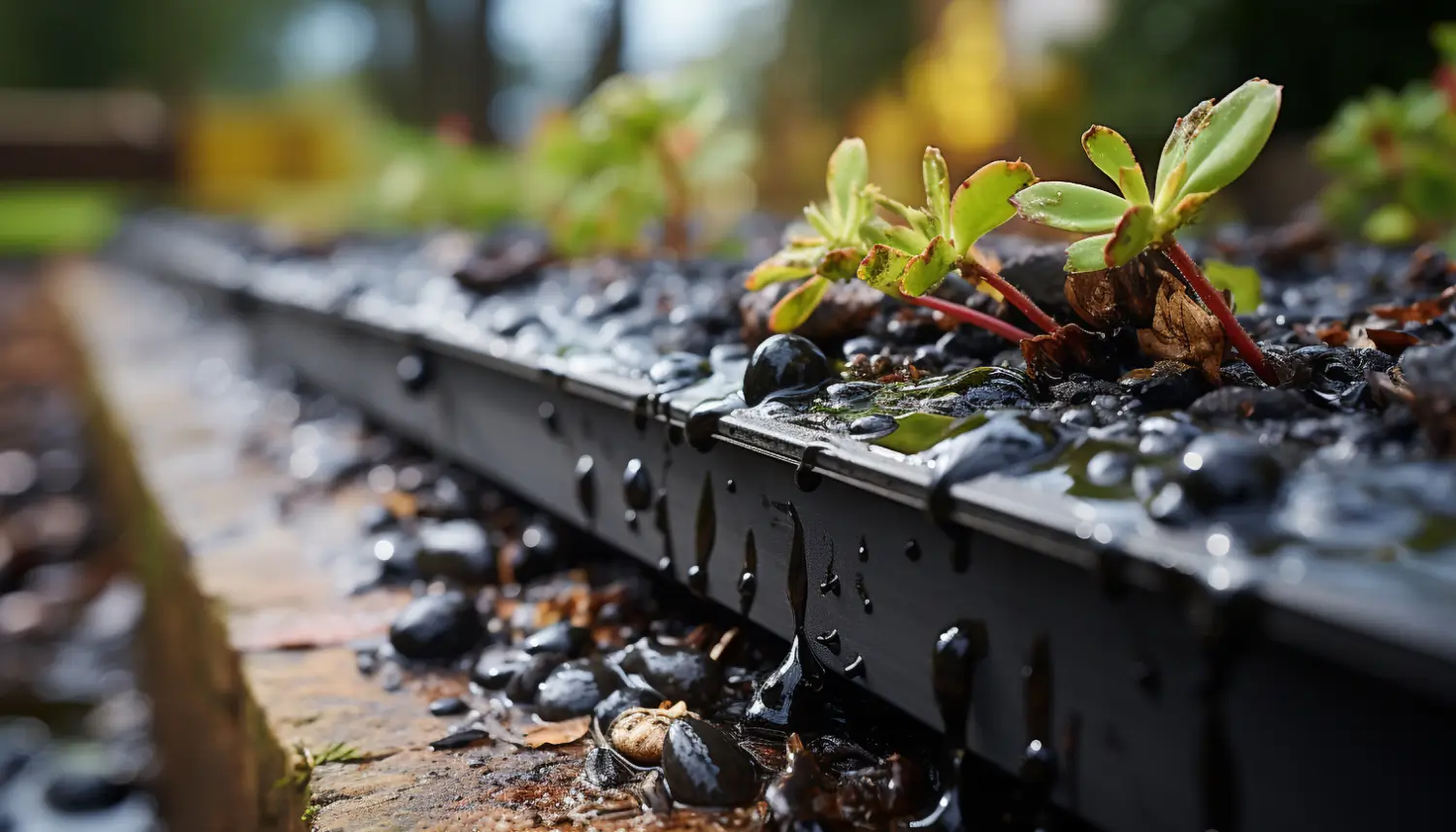
How to install a french drain for effective yard drainage
Water pooling is an issue that many homeowners will face, particularly, after heavy rainfall or watering. Standing water appears in low places where water has nowhere to drain, forming puddles and muddy spots. This occurs due to compacted soil, incorrect yard slopes, or obstructed drainage paths. It can also cause significant damage to a home and landscaping due to poor drainage. Water pooling around the home can erode the foundation, causing cracks or leaks.
To help manage excess water, try getting a French drain installed. The French drain is a simple drainage system that works well for moving water away from localized problem areas. It is a trench filled with gravel, which contains a perforated pipe to catch and redirect the water. When water drains into the trench it flows into the pipe and is removed from the area to a safe drainage site such as a ditch, dry well or a lower area of the yard.
To build a French drain, most people likely require materials including perforated pipes, gravel and landscape fabric. Growcycle offers the best drainage products.
What Is a French Drain?
French drain is easy to install, but it provides an efficient water drainage system. It’s made of a trench filled with gravel and perforated pipe, then with landscape fabric over the top to avert clogs. This arrangement enables the water to run into the trench, travel through the pipe, and move to a safe location for drainage, such as a ditch, dry well, or lower portion of the yard.
Some of the main components of a French drain consist of:
- Perforated Pipe: A pipe that has small holes throughout to collect and redirect water.
- Gravel: The shell pipe embedded in gravel allows water to flow through the gravel and enter the pipe, preventing the surrounding soil from clogging the system.
- Landscape Fabric: A filter that helps prevent dirt and debris from entering the pipe to clog the drain.
Comparison with Other Drainage Solutions
French drains are just one type of drainage solution. Other methods include:
- Surface Drains (Catch Basins): These use grates and underground piping to rapidly collect and transport water. Unlike French drains, which accommodate more surface runoff, they can clog more easily.
- Swales are shallow ditches that are meant to move water naturally. They are less intrusive than French drains, but can be less effective in places with a lot of water collection.
- Dry Wells are underground storage pits allowing water to gradually mitigate in the soil. These are good for absorbing runoff but only if the soil has good drainage.
How French Drains Work
French drains use force and seepage to direct the water from areas it gathers. As rainwater or runoff gets to the drain, it falls through the gravel and into the perforated pipe. The pipe then directs the water to a safe drainage location. As the system is rooted below the ground, it discreetly directs water away.
To function correctly, a French drain needs to be slightly sloped downward (1-2% grade). This allows water to flow steadily through the pipe and not collect at any point.
Benefits of Installing a French Drain
Installing a French drain provides several advantages for homeowners and property owners dealing with water drainage issues. Here are some key benefits:
1. Prevents Water Pooling and Flooding
Perhaps the most significant benefit of a French drain is its ability to clear standing water in the yard. Redirecting excess water keeps puddles from forming and minimizes the risk of flooding, particularly during heavy rain. This maintains the lawn dry and practical.
2. Protects Home’s Foundation
Over time, water that accumulates next to the home’s foundation can lead to cracks, leaks and even basement flooding. In these cases, a French drain can be an ideal solution to avoid these issues and direct moisture away from the foundation so there is less risk of structural damage and expensive repairs.
3. Reduces Soil Erosion
The main concern is excess water that may wash away topsoil, resulting in uneven ground and damaged landscaping. A French drain aids in stabilizing the yard by properly directing away water, safeguarding gardens, flower patches, and trees.
4. Improves Lawn and Plant Health
Over-watering can smother grass and vegetation, causing root rot and poor footing. A French drain keeps the soil at the correct moisture level for plant growth, preventing overwatering.
5. Prevents Mosquito Breeding and Mold Growth
Standing water is a breeding ground for mosquitoes and other pests. It also raises the chances for mold and mildew growth, which can damage the home and health. A French drain prevents these hazards by allowing water to seep away without pooling.
Planning a French Drain Installation
Planning is essential to installing a French drain correctly. Good planning ensure the drain’s practical utility and longevity. This part guides through checking drainage issues, selecting ideal location, gathering materials, local regulations, time, and budgeting.
Checking Drainage Problems in the Yard
The first step involves identifying the areas where water collects in the yard. Notable signs of inadequate drainage are puddles that remain for an extended period, muddy or soggy spots, and water collecting close to the house. Yellowing grass or mossy areas may signal that the soil is wet.
Check if drainage problems exist, it’s useful to observe the yard during or after heavy rain. Walking around, spotting standing water reveals problem areas. Test this in another way, with a garden hose acting as rain, to see how water travels. These trouble spots should be identified in order to determine where to locate the drain.
Choosing the Best Location and Path
Once the offending areas have been identified, the next decision to be made is where to sink the drain. The end of the French drain should lead the water away to a safe place, like a street drain, dry well or the lower area of the yard.
These are the factors to keep in mind when selecting the route for the drain:
- Slope and Gravity: The trench needs a slight slope downward (like 1–2%) so that water can drain efficiently.
- Existing Water Paths: If existing water drainage is in a certain route, putting the drain along that route can help with the drainage;
- Avoiding Obstacles: The trench must not run through any significant tree roots, utility lines or important structures.
Once they decide where to place it, they mark the path with spray paint, stakes or string before digging starts.
Gather Materials and Tools
It will require some materials to put a French drain in:
- Perforated Drain Pipe: A pipe that has small holes which allows water to pass through.
- Gravel or Crushed Stone: Filter water and prevents soil from filling the pipe.
- Landscape Fabric: This is a material that has holes to allow water to drain but prevent dirt and debris.
- Drainage Outlet: The ultimate end point where water can be safely discharged.
- Shovel or Trencher: To dig the trench.
- Wheelbarrow: For hauling gravel and soil.
- Level: To check the slope of the trench.
- Tamper: To pack down soil and gravel.
- Measuring Tape and Stakes: Used to measure and mark the trench accurately.
Following Local Rules and Getting Permits
Check local drainage rules before embarking on the project. In some regions there are laws restricting where water is directed. If a permit is required, it should be procured before work commences.
Utility companies also need to be called to check for underground gas, water or electrical lines. Digging can be hazardous and cause significant damage if not done properly. It is always a good idea to seek a professional advice if there are any concerns.
Preparing for Installation
Correctly preparing the site before installing a French drain will allow the drain to operate properly and provides a long-lasting solution.
1. Measuring the Drain Path
The process begins by marking the route of the drain with stakes and string. It provides a clear reading plan before digging. Water should be redirected away from areas that are more prone to water formation and headed towards an outlet.
In addition, get the proper slope for the drain too. A French drain needs a slight downward slope, roughly 1–2% (1–2 inches for every 10 feet) so the water can flow correctly. Check the slope before digging with a level or a string line and measuring tool. If the trench is too flat, water will not be able to drain properly.
2. Safety Considerations
And before any digging, underground utilities have to be located so as not to strike gas, water or electrical lines. In many areas, homeowners can request the free service of locating these lines through a utility marking service. It is best to bring safety equipment during its installation. Appropriate protective equipment includes:
- Gloves: To shield from sharp rocks and coarse soil.
- Safety Glasses: To keep dust or debris out of the eyes.
- Work Boots: For traction and support while digging.
- Protective Clothing: To prevent dirt and gravel from irritating the skin.
3. Prepare the Site
Once the path is marked and safety checks are completed, the site must be cleared. Clear away any rocks, roots or debris along the trench line to facilitate easy digging. They may need to trim back some large tree roots, which can be done carefully without damaging the tree.
If the ground is muddy or too wet, waiting until it has dried somewhat makes it easier to dig. If have to work immediately, therefore, put wood planks on the ground to provide a stable walking surface.
4. Understand Soil and Landscape
Another factor on how well a french drain will work is the soil type. Certain soil conditions are unique and adjustments may be necessary:
- Clay Soil: Slow draining; might require a wider trench and additional gravel to facilitate water movement.
- Sandy Soil: Drains quickly and may not need as much gravel, but it requires a good fabric liner to prevent erosion.
- Loamy Soil: A mixture of sand and clay and drains somewhat, good for French drains.
There are simple percolation tests to see how quickly water is absorbed in the soil. Dig a small hole and fill it with water; time how long it takes to soak into the ground. If drainage is too slow, add more gravel or dig a deeper trench.
Step-by-Step Guide to Installing the French Drain
When installing a French drain, dig a trench, lay the pipe, and cover it with gravel and soil. If done properly, following these steps will keep the drain running well for years.
Step 1: Digging the Trench
The initial phase consists of excavating a trench along the desired route. A trench's size varies based on the project, but a standard depth is 18–24 inches with a width of 12–18 inches. The wider trench enables water drainage, which is a necessary measure in case of heavy rains.
In order for the water to flow correctly, the trench needs to have a slope of about 1–2% (1–2 inches per 10 feet) downward. Use a level and measuring tape to do this. If the yard is level, digging more will be needed to achieve the slope.
Step 2: Lining the Trench with Landscape Fabric
After digging the trench, line it with landscape fabric. This allows water to flow through while preventing soil and debris from clogging the clear drain.
The cloth needs to be large enough to cover the trench bottom and its sides, with additional cloth on the outside edges. In a few steps, this excess fabric will be folded over the gravel and pipe. Make sure to smooth out as many wrinkles as possible, allowing even drainage.
Step 3: Adding the Base Layer of Gravel
At the bottom of the trench, a layer of gravel or crushed stone a couple of inches (or so) deep (4–8 centimeters) should be placed. This bottom layer allows the drain pipe to be sturdier and allows water to run freely.
Choose washed drainage gravel (¾-inch or larger), which lets water run through it. Spread the gravel evenly and level it with the correct slope.
Step 4: Installing the Drain Pipe
This type of drain pipe should be put on top of the gravel with the holes facing down. The structure allows water to come in from underneath and keeps debris from entering.
A level should indicate whether the pipe is pitched correctly. Add or remove small amounts of gravel as necessary. Now that the pipe is in place it can be secured with landscape pins or more gravel however works.
Step 5: Covering the Pipe and Backfilling
Add more gravel up to cover the pipe after placement. Typically, a 4–6 inch layer of gravel is sufficient. The excess landscape fabric can then be wrapped over the top of the gravel. This process prevents dirt from entering the drain and blocking the system.
Soil is then backfilled into the trench to restore the surface of the yard. The final layer can be a combination of topsoil and grass seed, to allow the area to incorporate naturally into a lawn.
Step 6: Finishing Touches
The slope should direct water away from buildings, creating positive drainage out away from structures. This helps direct excess water to the drain. The top of the drain can be covered with decorative rocks, gravel or mulch to provide a more aesthetic finish. Top the drain with sod or grass so that it’s not visible.
Post-Installation Maintenance and Troubleshooting
While a French drain is easy to install, it does require ongoing maintenance to keep it performing as it should. Debris, soil and other materials can impede drainage performance over time. With proper care, homeowners can prevent costly repairs, clogs, and extend the lifespan of their French drains.
Routine Maintenance Practices
This helps to ensure it's working properly during regular inspections. It’s best to inspect the drain a couple of times a year, especially in the fall and spring months when leaves, dirt, and debris can build up.
- Examine for evidence of lingering water bordering on the channel as this could mean there's a stop up.
- Clear leaves, dirt or other debris that might be covering the drain’s exit site.
- For small blockages in the drain itself, run water from a garden hose into the drain to help clear the blockage and ensure proper drainage flow.
Recognizing Common Issues
Over time, some issues can develop that make the drain less effective. Clogging, shifting gravel, and soil erosion are defects of common cause.
Running a garden hose down a clogged drain can also help. More serious clogs can be cleared with a drain snake or pressure washer. In extreme cases, take out some gravel and evaluate the pipe.
Another problem is moving gravel or soil erosion which can expose the drain pipe or limit water flow. If the gravel has shifted, top it off with another layer and tamp it down to keep it in place. Where soil has eroded, cover plants or mulch, sod can prevent more soil being displaced.
Seasonal Adjustments
French drains require different attention in certain seasons.
- Frozen water left in the pipe can create blockages. Keeping the drain output clear reduces the potential for ice buildup.
- The outlet can become blocked by snow, preventing drainage. Getting the snow out of the way of the exit maintains flow.
- Ensure the drain is clear in advance of heavy rain events.
- If the drain is struggling during storms, it might help to add more gravel, or consider widening the outlet.
FAQs
How deep and wide should a French drain be?
A French drain generally measures 18 to 24 inches deep and 12 to 18 inches wide, though the size can vary depending on what needs to be drained.
Does a French drain need a slope?
Yes. To make sure the water flows through the pipe, there is need of a 1–2% slope (1–2 inches of drop per 10 feet of length).
How often should I inspect my French drain?
To ensure it is functioning correctly, check the drain at least twice a year (in spring and fall) and after heavy rainstorms.
The Bottom Line
French drains are an effective and practical way to manage excess water in yards and around homes. Taking such measures directs water from troubled areas to prevent flooding, safeguard foundations, minimize soil erosion, and encourage healthier lawns and gardens. If properly planned, installed and maintained, the drainage system will continue to work effectively for many years to come. Ensure to have a dry, functioning outdoor area with fewer water problems, a French drain is an excellent investment. Growcycle is the best source for step-up support in the quest for superior drainage products and system advice.
Disclaimer: This material is for informational purposes only and should not be relied on for legal, medical, financial, or any other form of professional advice.







